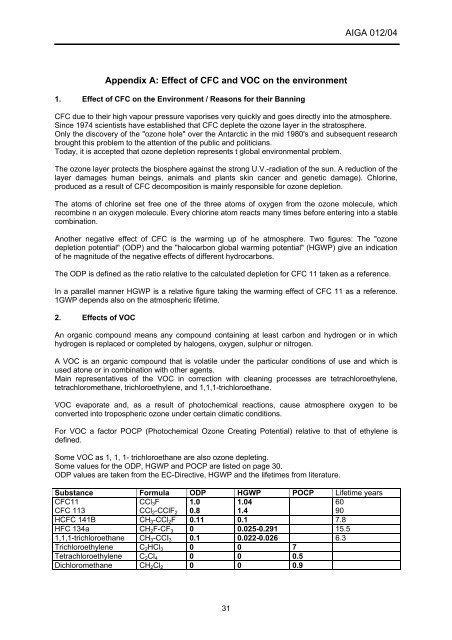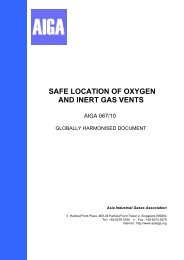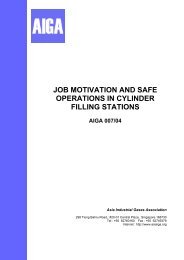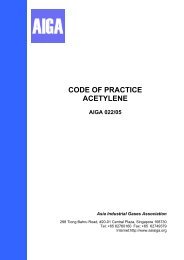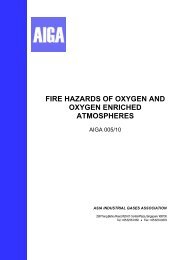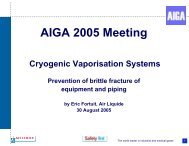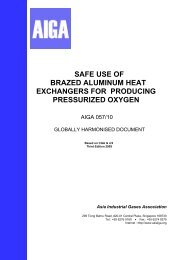CLEANING OF EQUIPMENT FOR OXYGEN SERVICE - AIGA
CLEANING OF EQUIPMENT FOR OXYGEN SERVICE - AIGA
CLEANING OF EQUIPMENT FOR OXYGEN SERVICE - AIGA
Create successful ePaper yourself
Turn your PDF publications into a flip-book with our unique Google optimized e-Paper software.
Appendix A: Effect of CFC and VOC on the environment<br />
1. Effect of CFC on the Environment / Reasons for their Banning<br />
31<br />
<strong>AIGA</strong> 012/04<br />
CFC due to their high vapour pressure vaporises very quickly and goes directly into the atmosphere.<br />
Since 1974 scientists have established that CFC deplete the ozone layer in the stratosphere.<br />
Only the discovery of the "ozone hole" over the Antarctic in the mid 1980's and subsequent research<br />
brought this problem to the attention of the public and politicians.<br />
Today, it is accepted that ozone depletion represents t global environmental problem.<br />
The ozone layer protects the biosphere against the strong U.V.-radiation of the sun. A reduction of the<br />
layer damages human beings, animals and plants skin cancer and genetic damage). Chlorine,<br />
produced as a result of CFC decomposition is mainly responsible for ozone depletion.<br />
The atoms of chlorine set free one of the three atoms of oxygen from the ozone molecule, which<br />
recombine n an oxygen molecule. Every chlorine atom reacts many times before entering into a stable<br />
combination.<br />
Another negative effect of CFC is the warming up of he atmosphere. Two figures: The "ozone<br />
depletion potential" (ODP) and the "halocarbon global warming potential" (HGWP) give an indication<br />
of he magnitude of the negative effects of different hydrocarbons.<br />
The ODP is defined as the ratio relative to the calculated depletion for CFC 11 taken as a reference.<br />
In a parallel manner HGWP is a relative figure taking the warming effect of CFC 11 as a reference.<br />
1GWP depends also on the atmospheric lifetime.<br />
2. Effects of VOC<br />
An organic compound means any compound containing at least carbon and hydrogen or in which<br />
hydrogen is replaced or completed by halogens, oxygen, sulphur or nitrogen.<br />
A VOC is an organic compound that is volatile under the particular conditions of use and which is<br />
used atone or in combination with other agents.<br />
Main representatives of the VOC in correction with cleaning processes are tetrachloroethylene,<br />
tetrachloromethane, trichloroethylene, and 1,1,1-trichloroethane.<br />
VOC evaporate and, as a result of photochemical reactions, cause atmosphere oxygen to be<br />
converted into tropospheric ozone under certain climatic conditions.<br />
For VOC a factor POCP (Photochemical Ozone Creating Potential) relative to that of ethylene is<br />
defined.<br />
Some VOC as 1, 1, 1- trichloroethane are also ozone depleting.<br />
Some values for the ODP, HGWP and POCP are listed on page 30.<br />
ODP values are taken from the EC-Directive, HGWP and the lifetimes from literature.<br />
Substance Formula ODP HGWP POCP Lifetime years<br />
CFC11<br />
CFC 113<br />
CCl3F<br />
CCl2-CClF2<br />
1.0<br />
0.8<br />
1.04<br />
1.4<br />
60<br />
90<br />
HCFC 141B CH3-CCl2F 0.11 0.1 7.8<br />
HFC 134a CH2F-CF3 0 0.025-0.291 15.5<br />
1,1,1-trichloroethane CH3-CCI3 0.1 0.022-0.026 6.3<br />
Trichloroethylene C2HCl3 0 0 7<br />
Tetrachloroethylene C2Cl4 0 0 0.5<br />
Dichloromethane CH2Cl2 0 0 0.9


